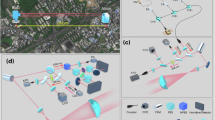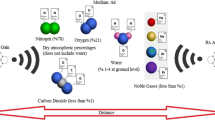Abstract
We discuss the feasibility of continuous-variable wireless quantum key distribution (WQKD) with thermal Gaussian states in terahertz (THz) band. We rigorously analyze the secret key rate of practical WQKD system using direct reconciliation and homodyne detection against collective Gaussian attacks. The results show that in the case of low-gain antenna, the free space loss is the dominant limiting factor of secure transmission distance of THz WQKD system. When the antenna diameter increases from 1 to 5 cm, we can get the maximum security distance and its corresponding optimal frequency in the range of 0.1–1 THz. We also obtain that a security distance of 1.95 m can be achieved when using a 5-cm diameter antenna and controlling the excess noise below 0.25 simultaneously. Specifically, we study the finite size effects and show that the transmission distance can reach 78 cm with a 5-cm diameter antenna at the frequency of 300 GHz. This work takes an important step toward short distance wireless QKD system.








Similar content being viewed by others
Explore related subjects
Discover the latest articles, news and stories from top researchers in related subjects.References
Bennet, C.H.: Quantum cryptography: public key distribution and coin tossing. In: Proceedings of IEEE International Conference on Computer, System and Signal Processing, Bangalore, India, 10–12 Dec 1984 (1984)
Bennett, C.H.: Quantum cryptography using any two nonorthogonal states. Phys. Rev. Lett. 68(21), 3121 (1992)
Grosshans, F., Grangier, P.: Continuous variable quantum cryptography using coherent states. Phys. Rev. Lett. 88(5), 057,902 (2002)
Scarani, V., Bechmann-Pasquinucci, H., Cerf, N.J., Dušek, M., Lütkenhaus, N., Peev, M.: The security of practical quantum key distribution. Rev. Mod. Phys. 81(3), 1301 (2009)
Weedbrook, C., Pirandola, S., García-Patrón, R., Cerf, N.J., Ralph, T.C., Shapiro, J.H., Lloyd, S.: Gaussian quantum information. Rev. Mod. Phys. 84(2), 621 (2012)
Korzh, B., Lim, C.C.W., Houlmann, R., Gisin, N., Li, M.J., Nolan, D., Sanguinetti, B., Thew, R., Zbinden, H.: Provably secure and practical quantum key distribution over 307 km of optical fibre. Nat. Photonics 9(3), 163 (2015)
Schmitt-Manderbach, T., Weier, H., Fürst, M., Ursin, R., Tiefenbacher, F., Scheidl, T., Perdigues, J., Sodnik, Z., Kurtsiefer, C., Rarity, J.G.: Experimental demonstration of free-space decoy-state quantum key distribution over 144 km. Phys. Rev. Lett. 98(1), 010,504 (2007)
Liao, S.K., Cai, W.Q., Liu, W.Y., Zhang, L., Li, Y., Ren, J.G., Yin, J., Shen, Q., Cao, Y., Li, Z.P., et al.: Satellite-to-ground quantum key distribution. Nature 549(7670), 43 (2017)
Elser, D., Bartley, T., Heim, B., Wittmann, C., Sych, D., Leuchs, G.: Feasibility of free space quantum key distribution with coherent polarization states. New J. Phys. 11(4), 045,014 (2009)
Qu, Z., Djordjevic, I.B.: Four-dimensionally multiplexed eight-state continuous-variable quantum key distribution over turbulent channels. IEEE Photonics J. 9(6), 1–8 (2017)
Elmabrok, O., Razavi, M.: Feasibility of wireless quantum key distribution in indoor environments. In: 2015 IEEE Globecom Workshops (GC Wkshps), pp. 1–2. IEEE (2015)
Elmabrok, O., Razavi, M.: Wireless quantum key distribution in indoor environments. JOSA B 35(2), 197–207 (2018)
Weedbrook, C., Pirandola, S., Lloyd, S., Ralph, T.C.: Quantum cryptography approaching the classical limit. Phys. Rev. Lett. 105(11), 110,501 (2010)
Garcia-Patron, R.: Quantum information with optical continuous variables: from bell tests to key distribution. Ph.D dissertation, Université Libre de Bruxelles (2008)
Grosshans, F., Van Assche, G., Wenger, J., Brouri, R., Cerf, N.J., Grangier, P.: Quantum key distribution using gaussian-modulated coherent states. Nature 421(6920), 238 (2003)
Weedbrook, C., Pirandola, S., Ralph, T.C.: Continuous-variable quantum key distribution using thermal states. Phys. Rev. A 86(2), 022,318 (2012)
Weedbrook, C., Ottaviani, C., Pirandola, S.: Two-way quantum cryptography at different wavelengths. Phys. Rev. A 89(1), 012,309 (2014)
Weedbrook, C., Lance, A.M., Bowen, W.P., Symul, T., Ralph, T.C., Lam, P.K.: Quantum cryptography without switching. Phys. Rev. Lett. 93(17), 170504 (2004)
Renner, R.: Security of quantum key distribution. Int. J. Quantum Inf. 6(01), 1–127 (2008)
Grosshans, F., Cerf, N.J., Wenger, J., Tualle-Brouri, R., Grangier, P.: Virtual entanglement and reconciliation protocols for quantum cryptography with continuous variables. Quantum Inf. Comput. 3(7), 535–552 (2003)
Nielsen, M.A., Chuang, I.L.: Quantum Computation and Quantum Information. Cambridge University, Cambridge/New York (2000)
Wolf, M.M., Giedke, G., Cirac, J.I.: Extremality of gaussian quantum states. Phys. Rev. Lett. 96(8), 080,502 (2006)
García-Patrón, R., Cerf, N.J.: Unconditional optimality of gaussian attacks against continuous-variable quantum key distribution. Phys. Rev. Lett. 97(19), 190,503 (2006)
Leverrier, A., Grangier, P.: Simple proof that gaussian attacks are optimal among collective attacks against continuous-variable quantum key distribution with a gaussian modulation. Phys. Rev. A 81(6), 062,314 (2010)
Wang, R., Yao, J., Xu, D., Wang, J., Wang, P.: The physical theory and propagation model of thz atmospheric propagation. In: Journal of Physics Conference Series, vol. 276 (2011)
Siegel, P.H.: Terahertz technology. IEEE Trans. Microw. Theory Tech. 50(3), 910–928 (2002)
Hosako, I., Sekine, N., Patrashin, M., Saito, S., Fukunaga, K., Kasai, Y., Baron, P., Seta, T., Mendrok, J., Ochiai, S.: At the dawn of a new era in terahertz technology. Proc. IEEE 95(8), 1611–1623 (2007)
Cetnar, J.S.: Atmospheric effects on the propagation of mmw and sub-mmw radiation. Ph.D. thesis, Wright State University (2010)
Hewison, T.J., Cimini, D., Martin, L., Gaffard, C., Nash, J.: Validating clear air absorption models using ground-based microwave radiometers and vice-versa. Meteorol. Z. 15(1), 27–36 (2006)
Schneider, T., Wiatrek, A., Preußler, S., Grigat, M., Braun, R.P.: Link budget analysis for terahertz fixed wireless links. IEEE Trans. Terahertz Sci. Technol. 2(2), 250–256 (2012)
Piesiewicz, R., Kleine-Ostmann, T., Krumbholz, N., Mittleman, D., Koch, M., Schoebei, J., Kurner, T.: Short-range ultra-broadband terahertz communications: concepts and perspectives. IEEE Antennas Propag. Mag. 49(6), 24–39 (2007)
Kleine-Ostmann, T., Nagatsuma, T.: A review on terahertz communications research. J. Infrared Millim. Terahertz Waves 32(2), 143–171 (2011)
Lodewyck, J., Bloch, M., García-Patrón, R., Fossier, S., Karpov, E., Diamanti, E., Debuisschert, T., Cerf, N.J., Tualle-Brouri, R., McLaughlin, S.W.: Quantum key distribution over 25 km with an all-fiber continuous-variable system. Phys. Rev. A 76(4), 042,305 (2007)
Virginia diodes inc. http://vadiodes.com/en/products/straight-waveguides-tapers-horn-antenna-directional-couplers. Accessed 16 Dec 2017
Nagatsuma, T.: Terahertz technologies: present and future. IEICE Electron. Express 8(14), 1127–1142 (2011)
Vitiello, M.S., Scalari, G., Williams, B., De Natale, P.: Quantum cascade lasers: 20 years of challenges. Opt. Express 23(4), 5167–5182 (2015)
Momeni, O., Afshari, E.: High power terahertz and millimeter-wave oscillator design: a systematic approach. IEEE J. Solid-State Circuits 46(3), 583–597 (2011)
Homes, C.C., Carr, G.L., Lobo, R.P., LaVeigne, J.D., Tanner, D.B.: Silicon beam splitter for far-infrared and terahertz spectroscopy. Appl. Opt. 46(32), 7884–7888 (2007)
Ung, B.S.Y., Weng, B., Shepherd, R., Abbott, D., Fumeaux, C.: Inkjet printed conductive polymer-based beam-splitters for terahertz applications. Opt. Mater. Express 3(9), 1242–1249 (2013)
Berry, C.W., Wang, N., Hashemi, M.R., Unlu, M., Jarrahi, M.: Significant performance enhancement in photoconductive terahertz optoelectronics by incorporating plasmonic contact electrodes. Nat. Commun. 4, 1622 (2013)
Komiyama, S.: Single-photon detectors in the terahertz range. IEEE J. Sel. Top. Quantum Electron. 17(1), 54–66 (2011)
Sheikh, F., Zarifeh, N., Kaiser, T.: Terahertz band: channel modelling for short-range wireless communications in the spectral windows. IET Microw. Antennas Propag. 10(13), 1435–1444 (2016)
Friis, H.T.: A note on a simple transmission formula. Proc. IRE 34(5), 254–256 (1946)
Jornet, J.M., Akyildiz, I.F.: Channel modeling and capacity analysis for electromagnetic wireless nanonetworks in the terahertz band. IEEE Trans. Wirel. Commun. 10(10), 3211–3221 (2011)
Sector, I.R.: Recommendation itu-r p. 676–10, attenuation by atmospheric gases. International Telecommunications Union (2013)
Müller-Quade, J., Renner, R.: Composability in quantum cryptography. New J. Phys. 11(8), 085,006 (2009)
Leverrier, A., Alléaume, R., Boutros, J., Zémor, G., Grangier, P.: Multidimensional reconciliation for a continuous-variable quantum key distribution. Phys. Rev. A 77(4), 042,325 (2008)
Leverrier, A., Grangier, P.: Unconditional security proof of long-distance continuous-variable quantum key distribution with discrete modulation. Phys. Rev. Lett. 102(18), 180,504 (2009)
Leverrier, A., Grosshans, F., Grangier, P.: Finite-size analysis of a continuous-variable quantum key distribution. Phys. Rev. A 81(6), 062,343 (2010)
Braunstein, S.L., Van Loock, P.: Quantum information with continuous variables. Rev. Mod. Phys. 77(2), 513 (2005)
Acknowledgements
This work was supported by National Natural Science Foundation of China (Grant Nos. 61372076, 61301171), Shaanxi Key Research and Development Program (Grant No. 2017GY-080), Foundation of Science and Technology on Communication Networks Laboratory (KX172600031) and the 111 Project (No. B08038).
Author information
Authors and Affiliations
Corresponding author
Appendices
Appendix A: Calculation of information entropy
The information entropy is described by the second-order statistical properties, including variance, covariance, and conditional variance. Firstly, we define the quadrature row vector \(\hat{\mathbf {Y}}=(\hat{Q}_1,\hat{P}_1,\ldots ,\hat{Q}_k,\hat{P}_k)\), which describes the bosonic system of k-mode and its elements satisfy the commutator relation [50]. The correlation matrix (CM) of the Gaussian bosonic state \(\rho \) can be calculated by using the following formulas. The off-diagonal terms of CM are defined by
and the diagonal terms of CM are
The conditional variance is
The Shannon entropy is calculated as
The von Neumann entropy of a Gaussian state \(\rho \) containing k-mode can be written as [5]
where
where \(\nu _{i}\) corresponds to the symplectic eigenvalues of the ith of the k-mode Gaussian bosonic system and is given by
where \(\nu \ge 1\), \(\varvec{\Gamma }\) corresponds to the CM of the Gaussian bosonic state \(\rho \) and
where \(\bigoplus \) is direct sum.
We consider the case of two-mode bosonic Gaussian system to calculate the secure key rate, i.e., \(k=2\), \(\hat{\mathbf {Y}}=(\hat{Q}_{A},\hat{P}_{A},\hat{Q}_{B},\hat{P}_{B})\). Based on Eqs. (5), (A.1), and (A.2), the covariance matrix \({{\varvec{\Gamma }}_{AB}}\) of the state \(\rho _{AB}\) shared by Alice and Bob can be obtained.
Similarly, other elements of \({{\varvec{\Gamma }}_{AB}}\) can be calculated. \({{\varvec{\Gamma }_{AB}}}\) is given by
where \(\mathbf {I}\) is the \(2\times 2\) identity matrix and \(\varvec{\sigma }_{z}={\hbox {diag}}(1,-1)\). To represent concisely, we denote
therefore
We first calculate the covariance matrix \(\varvec{\Gamma }_{A_{0}C_{0}B}\)
As shown in Fig. 1, \(\hat{A}_{0}\) and \(\hat{C}_{0}\) are coupled through the beam splitter with \(T_{A}=0.5\). \(\varvec{\Gamma }_{ACB}\) can be calculated as
After Alice performs homodyne detection according to Eq. (7), we can get
\(S(\rho _{AB} )\) is a function of the symplectic eigenvalues \(\nu _{1,2}\) of \(\varvec{\Gamma }_{AB}\) and \(S(\rho _{BC}|x)\) is a function of the symplectic eigenvalues \(\nu _{3,4}\) of \(\varvec{\Gamma }_{BC|x}\). Combined with Eqs. (A.5)–(A.8), (A.11), and (A.15), we can get
where
Finally, by Eqs. (11), (12), (A.5), and (A.16), we can get the security key rate R.
Appendix B: The estimation of CM
We consider here a normal model for x and y as
where t is \(\sqrt{T}\) and z is a normal variable with unknown variance \(\sigma ^{2}\). Therefore, \(S_{\varepsilon _\mathrm{PE}}(x:E)\) is a function of t and \(\sigma ^2\). At this point, it is worth considering the dependence of \(S_{\varepsilon _\mathrm{PE}}(x:E)\) on the variables t and \(\sigma ^{2}\):
For maximizing the Holevo information between Eve and Alice’s classical data, we need to estimate \(t_\mathrm{min}\) and \(\sigma ^2_\mathrm{max}\) through the sampling of m couples of correlated variables \((x_{i}, y_{i})_{i=1, \ldots , m}\). We can obtain the estimated value of t and \(\sigma ^{2}\) by the maximum likelihood estimation:
where \(\hat{t}\) and \(\hat{\sigma }^{2}\) are independent estimators. By the large number theorem, we can get the following distributions:
where t and \(\sigma ^2\) are the values of the parameters. We expect their estimated values to be as close as possible to the true values, i.e., \( E(\hat{t} )=\sqrt{T}\) and \(E(\hat{\sigma }^2 )=(1-T)W+T\). As we mentioned before, the failure probability of parameters estimation is \(\varepsilon _\mathrm{PE}\) and the error function is defined as
Therefore, when the confidence probability \(\delta \) is \(\varepsilon _\mathrm{PE}/2\), we can compute the confidence interval for \(\hat{t}\), \(\hat{\sigma }^2\) as
where \(z_{\delta }\) satisfies \(1-erf(\frac{z_{\delta }}{\sqrt{2}})/2=\delta \).
Rights and permissions
About this article
Cite this article
Liu, X., Zhu, C., Chen, N. et al. Practical aspects of terahertz wireless quantum key distribution in indoor environments. Quantum Inf Process 17, 304 (2018). https://doi.org/10.1007/s11128-018-2068-6
Received:
Accepted:
Published:
DOI: https://doi.org/10.1007/s11128-018-2068-6




